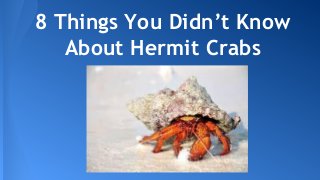
8 Things You Didn't Know About Hermit Crabs
- 1. 8 Things You Didn’t Know About Hermit Crabs
- 2. Hermit crabs are popular pets for ocean lovers and families with other pet allergies. But before you commit to a tank full of these little critters, you should know a few things about what they are, where they come from, how to take care of them, and what kind of hermit crab food they need. Learning about hermit crabs
- 3. The little decapod crustaceans we know as hermit crabs are not true crabs. Even though they have ten legs like other crabs, they do not grow the typically hard shell on their back to protect them from predators. Instead, hermit crabs rely on the shells of other animals to keep them safe. 1. They aren’t crabs
- 4. Hermit crabs must molt to grow, which means it sheds a layer of skin to make way for a bigger body. Most healthy hermit crabs molt about once every 18 months, though the speed of growth for different sized hermit crabs and the right conditions can cause more or less frequent molting. Hermit crabs can regenerate limbs and claws during a molting phase. 2. They molt
- 5. Hermit crabs are nocturnal creatures, staying more active at night than during the day. Hermit crabs also love to climb, hide, scuttle, and burrow. Learn how to care for your hermit crab from the experts at Pisces Pros. 3. They’re nocturnal.
- 6. Hermit crabs are called crabs because they move from shell to shell as they grow, never staying in one size for very long. They carry their mobile homes on their backs, allowing them to remain safe wherever they go. The ideal shell is big enough for a hermit crab to pull all of their appendages inside and light enough to carry around without tiring quickly. You can set up your own crabitat (a habitat for hermit crabs) at home. Find out how at www.piscespros.com. 4. They carry their own homes.
- 7. Hermit crabs prefer to live in groups rather than alone, despite the moniker “hermit.” When kept in captivity, most hermit crabs are happier when there are more than one in a cage. In fact, many hermit crab experts suggest having at least three in a group for proper social interaction; otherwise the health of the crab deteriorates. Hermit crabs are prevalent in tropical areas in and around the ocean. They can live in saltwater or freshwater, particularly enjoying brackish water where there are abundant food sources, plenty of abandoned shells, and many places to hide. 5. They’re social beings
- 8. And scavengers. Hermit crab foods range widely and food for hermit crabs can be plant or animal-based. In the wild, a hermit crab food list might include seaweed, driftwood, snails, or dead fish and other animals. Find out what to feed your hermit crab here. 6. They’re omnivores
- 9. Did you know there are 1170 varieties of hermit crab? And each hermit crab is slightly different with the opportunity to be left or right claw dominant just like humans are right or left handed. They can also have a wide range of eye colors. 7. They come in thousands of varieties
- 10. Some hermit crabs have been known to live as long as 32 years in captivity, though most only live between 5 and 15 years. Older hermit crabs can get to the size of a softball. Certain hermit crab food is designed to provide essential nutrients which promote growth, appetite, coloration, and health. 8. They might live longer than your cat.
- 11. Feed your hermit crab the best. Contact Pisces Pros today for the highest quality hermit crab foods on the market at the most affordable prices possible. Email at info@piscespros.com, or call 385-244-2221.